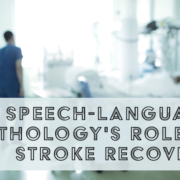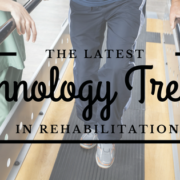A Day in the Life of a Speech-Language Pathologist
It can be difficult to fully describe the role of a Speech-language Pathologist, as the rehabilitative work they do throughout their days is extremely varied and complex. In order to give our readers a more accurate idea of what an SLP does, we asked one to tell us a little more about her patient work here at an Ernest Health Hospital, as well as walk us through her activities throughout the day.
EH: Can you share with us what a typical day looks like for you?
SLP: I get to work around 7 or 7:30 a.m. to help patients with using their safe swallow strategies during breakfast.
We have a short staff meeting at 8:00 to quickly discuss appointments, discharge plans, medical complications, etc. I treat patients from 8:30 to 12. I personally have more energy in the morning, so I try to see my patients then and save documentation for the afternoon
I document daily/weekly progress notes during lunch and begin therapy again at 1:00. I have 2-3 sessions in the afternoon, and then I need to write daily/weekly notes. Part of my role in the afternoon is to look at the patients we will have in the evening and which therapists will be coming in for the evening shift and get the patients signed out to a therapist accordingly.
Some of the things that I have to think about as I’m evaluating patients is: Are the patients sticking to their diet? Are they ready for advancement? How are they handling the diet?
EH: What does the majority of your work involve at Ernest Health, and how would you describe the majority of the patients you work with?
SLP: I provide individual sessions and group therapy sessions two days a week. The majority of my patients have cognitive impairments that limit their ability to make safe decisions.
Stroke and head injury are the majority of the causes.
EH: What treatments/therapies do you use to work with your patients at Ernest Health?
SLP: For dysphagia (swallowing issues): I use myofascial release therapy and e-stim (electrical stimulation) modalities.
Myofascial release therapy is a treatment for patients with dysphagia that aims to loosen up muscles in the cervical area to allow for more contraction in swallowing.
E-stim modalities are used for neuromuscular re-education, which is a technique used to help the patient contract the muscles used in swallowing to teach the patient what it should feel like. E-stim machines can be used for a variety of purposes, though, and all depends on the settings (pain management, muscle contractions, etc.).
One of our SLP’s main focuses is keeping the patient safe by educating them and family members on things like locking the wheelchair and using the call light for help. In addition to these practices, she also does her best to find fun and fresh ways to help retrain patients to their former levels of functionality. Using music therapy and technology like iPad games, for instance, allows the patient to learn in a way that feels less like work and more like recreation.
.
Her empathy for the patients, dedication, and caring personality are shining examples of the qualities that Ernest Health values in its team members.
EH: Why did you choose Speech-Language Pathology as a career?
SLP: I chose to be an SLP because I wanted a career that would make a positive impact on someone’s life.
My first semester in undergrad, I, by chance, saw a class schedule with a class about Communication Disorders. I decided to take it and knew from the beginning this was what I wanted to do with my life.
EH: What hobbies or interests do you have?
SLP: I teach fitness classes before and/or after work. My alarm usually goes off at 4:30 so I can fit in my hobbies. My husband and I enjoy traveling, skiing, and fly fishing together.











Leave a Reply
Want to join the discussion?Feel free to contribute!